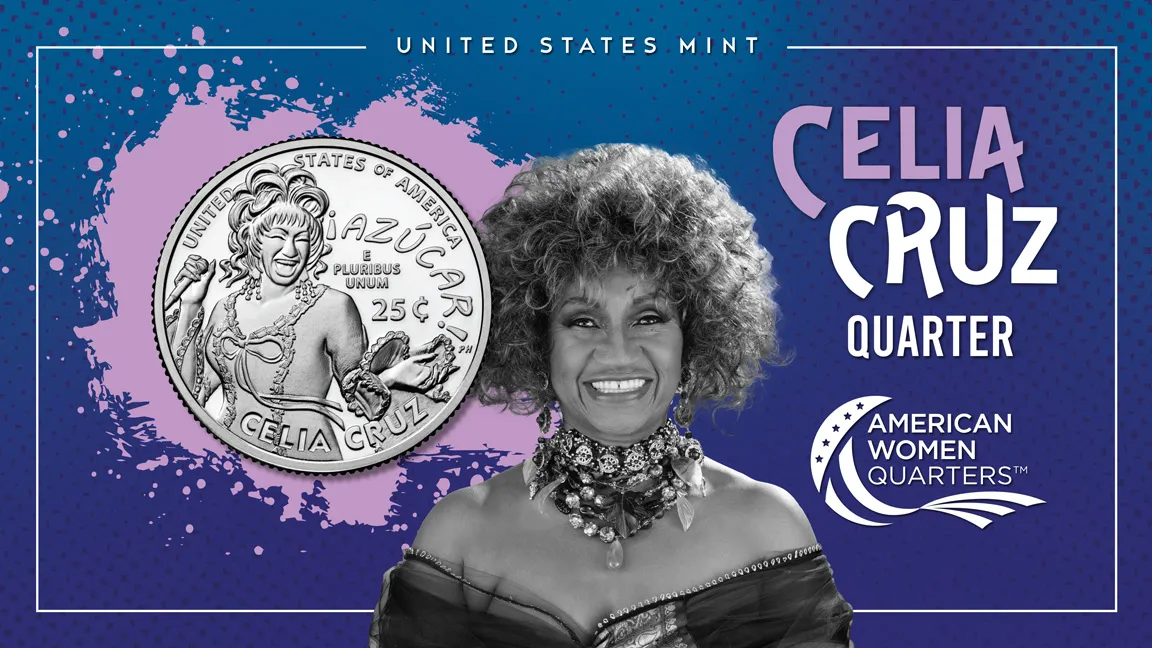U.S. quarters bearing the image of the Cuban-American “Queen of Salsa” Celia Cruz are now in circulation, a first for an Afro-Latinx person and the second-ever for a musician.
The news comes just ahead of the centennial birth anniversary of the award-winning singer, one of the most recognizable Latin music stars of the 20th century. She is one of two Black individuals honored in this year’s American Women Quarters program, run by the U.S. Mint since 2022 to honor the centennial of women’s suffrage in the United States.
“Celia Cruz’s influence reached well beyond her music,” said Mint Director Ventris C. Gibson. “She was proud of and celebrated her Cuban culture, which empowered Afro-Latino Americans in embracing their heritage, making her an important and enduring cultural icon.”
Celia Cruz influenced well beyond her 🎶. She celebrated her Cuban culture that helped other Afro-Latino Americans embrace their heritage, making her a cultural icon. Cruz is the 14th honoree featured in the American Women Quarters™ Program. https://t.co/Tya9Ibxp1v #HerQuarter pic.twitter.com/IsFVMQJrpZ
— United States Mint (@usmint) August 21, 2024
Born in Havana in 1925, Cruz first gained fame as a member of La Sonora Matancera in the mid to late 20th century, before the travails of the Cuban Revolution. Effectively exiled as an outspoken dissident when the nation’s music industry was nationalized by Fidel Castro, Cruz immigrated to North America in 1961, first resuming her career in Mexico before settling in New Jersey.
Despite performing in Spanish throughout her career, Cruz became a household name among American music listeners of various stripes. She was also known for her collaborations within the Latin music genre, including an early hit, “Bemba Colorá,” with Tito Puente in 1966 and continued success with the salsa smash “Quimbara” alongside Johnny Pacheco in 1974.
Known for her flashy style both on the stage and with the microphone, Cruz made numerous landmark concert appearances, including at the famed George Forman-Muhammad Ali “Rumble in the Jungle” fight in Zaire, where she performed with the salsa supergroup, the Fania All-Stars. She played Madison Square Garden in 1982, and broke a world record for the largest free-entry outdoor concert five years later when she serenaded 250,000 at Santa Cruz de Tenerife in the Canary Islands.
Phebe Hemphill designed the image used on Cruz’s new quarter, which reflects her bombastic persona and presence (as well as her signature catchphrase “¡Azúcar!”).
“I knew I had to make the design for superstar Celia Cruz as dynamic as she was,” said Hemphill. “I watched her perform in her famous rumba dress and tried to create a design that truly reflected her greatness and vitality.”
U.S. Rep. Adriano Espaillat of New York, one of the nation’s Black Catholic congressmen and an Afro-Latino himself, also expressed admiration for Cruz’s legacy not only as a singer but as a general icon.
“Celia Cruz dedicated her life to freedom of expression,” he wrote on social media. “Today and always, we honor her global impact to music, dance, and culture!”
Celia Cruz dedicó su vida a la libertad de expresión. ¡Hoy y siempre honramos su impacto global en la música, la danza y la cultura!
— Adriano Espaillat (@RepEspaillat) August 14, 2024
Cruz was nominated for 14 Grammys during her more than five-decade career, including a win for Best Tropical Latin Recording in 1990 for “Ritmo En El Corazón”—the same year she triumphantly returned to Cuba for a presentation at Guantanamo Bay—and for Best Salsa/Merengue Album in 2003 with one of her last recordings, “Regalo del Alma.” She was also nominated for seven Latin Grammys, winning four times.
Diagnosed with breast and brain cancer in 2002, Cruz continued to perform and record up to the end of her life. She finished her final album in 2003 and died that July at the age of 77. A lifelong Catholic, Cruz was funeralized at St. Patrick’s Cathedral in New York.
She posthumously received a Grammy Lifetime Achievement Award in 2016 and was also the recipient of various civic honors during her career, including a star on the Hollywood Walk of Fame in 1987 and Celia Cruz Way, a street renamed in her honor in Miami in 1991. (An identically named intersection in the Bronx was christened in 2021.)
Cruz's new commemorative quarter, which entered circulation in late July and is also available for purchase, is only her latest honor from the federal government, including the National Medal of Arts in 1994—the nation’s highest government honor for artists—and a commemorative stamp issued by the U.S. Postal Service in 2011. Her portrait was enshrined in the Smithsonian’s National Museum of American History the following year.
“Celia received so many accolades during her lifetime that it was hard to expect a greater honor than those she had already accumulated during her legendary career. But to have been honored by the U.S. Mint in this way is something that would have surprised her greatly since she was a simple and humble woman,” said Omer Pardillo-Cid, Cruz's last artistic representative and the executor of her estate.
“The adjective 'unique' has been used a great deal, but I really can't find another that is more correct to describe Celia Cruz. Unique and eternal.”
Nate Tinner-Williams is co-founder and editor of Black Catholic Messenger.









